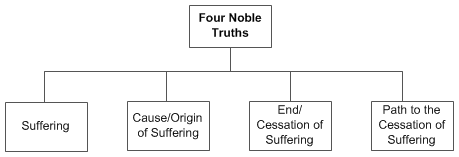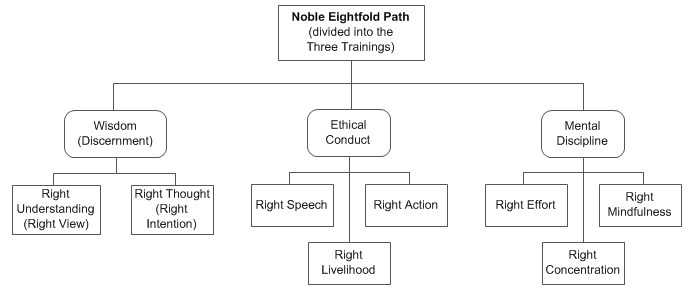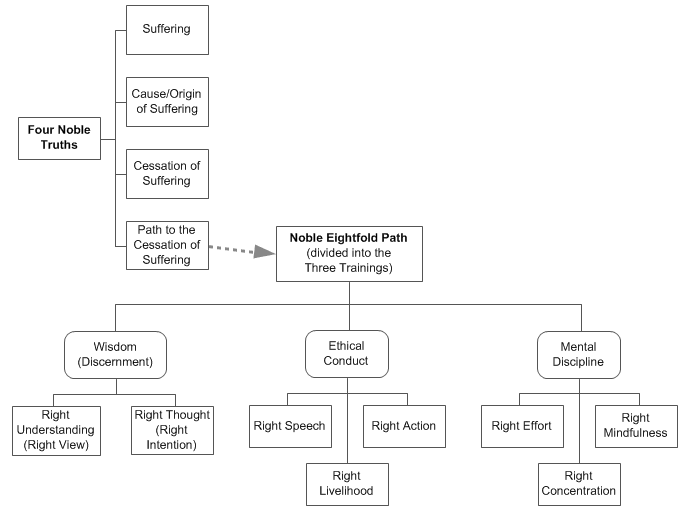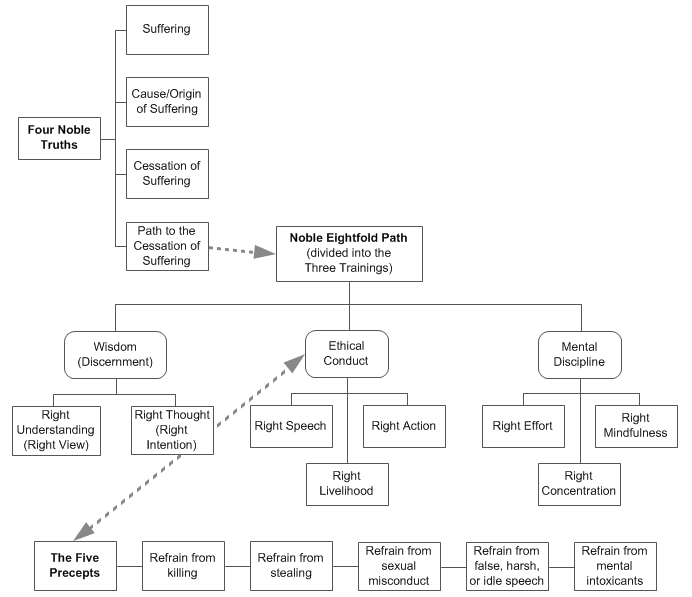Graphic Organizers and Buddhism
Buddhism? Really?
"…whether or not you have any interest at all in Buddhism… you may see how you can apply a similar approach to assimilate and organize information about interests of your own."
Examples can be more illuminating than a thousand wordy explanations. I'd like to offer this personal example of how graphic organizers can be used in just about any field you study.
For the last several months, I've been learning about Buddhism on my own, using mostly books and online resources. Maybe it doesn't sound like a promising application for graphic organizers, but it turns out that GOs really do help me organize, summarize, and visualize the many sources of info I'm reading. Like most newcomers to a field of study, I quickly find that the more I know, the more I realize I don't know. And like exploring any unfamiliar territory, I realize I need to grab hold of some basic concepts before I can hope to deepen my understanding and absorb information more effectively. I think of these first few months of study as laying this groundwork, building a scaffold of basic concepts so that, as I continue, I have a structure on which to "hang" more difficult, complex concepts.
So whether or not you have any interest at all in Buddhism, I hope you'll follow along with me on this little adventure. By doing so, you may see how you can apply a similar approach to assimilate and organize information about interests of your own, and thus increase your repertoire of expert learner strategies. With this particular article, my intent is to give a very personal example of how I'm using graphic organizers to help me approach a new interest. What I'm finding along the way is that making the effort to create alternative representations of all the words I'm reading—there are so many words—is benefitting me in multiple and sometimes unexpected ways. Among them are the abilities to:
- Organize content
- Summarize content
- See the relationships among concepts
- See the big picture in a whole new way
- Zoom in on a particular part of the big picture with a more detailed GO
- Retain information better because I've engaged with it deeply in order to create a GO
- Visualize concepts, their components, and their interrelationships more easily due to making the effort to translate words in long paragraphs into succinct diagrams
So here's how it's evolving…
The Four Noble Truths

While reading introductory Buddhist sources, I run across something called the Four Noble Truths over and over again. This seems like a good jumping-in point for study as well as a good candidate for a branching diagram. The basic idea is that, in life, there is suffering, there are causes for suffering, there can be an end to suffering, and there is a path to that end. Different sources word the truths differently, explain them differently, etc., but I try to summarize what makes the most sense to me (see Figure 1).
The Noble Eightfold Path
The fourth Noble Truth—the path to the end of suffering—leads me to another key Buddhist teaching—the Noble Eightfold Path—because the Eightfold Path is the way to the cessation of suffering. My first impulse is to render the Path as a process diagram—you know, do step one, then step two, on through step eight, and then, WHAM, you're enlightened! But further reading indicates that the Path is not an ordered list of steps (nor is enlightenment quite that easy to come by). However, the eight aspects are typically grouped into three categories, sometimes referred to as the three trainings. So once again, a branching diagram—this time a multi-level one—seems to express this best (see Figure 2).

At this point, I reflect that one mistake I've made in past learning endeavors is to compartmentalize information. I would commit to memory each little nugget as if it were a discrete, disconnected bit of knowledge to be digested alone and stored in its own little cubbyhole. That kind of rote learning allowed me to perform very well on objective tests back in high school, but I can't think of a single discipline that is really like that! Concepts connect and make a bigger picture. That's part of the excitement of learning new things, after all—discovering those connections and understanding key concepts within their larger context. So I decide to show the relationship between the Four Noble Truths and the Noble Eightfold Path in the first of many versions of my "master" Buddhism GO. After experimenting, I decide that things seem to fit better if I turn the Four Noble Truths section on its side (see Figure 3).

The Five Precepts
As I continue my exploration of Buddhism, I note several references to the Five Precepts or Five Virtues for lay Buddhists (as opposed to monks and nuns), i.e., some specific guidelines for living in a wholesome and ethical way. They are not presented as commandments or imperatives, but rather as training rules that one takes on voluntarily. They seem to be based on the intent to avoid doing harm to any living being, including oneself. Interestingly, I find the precepts addressed in two very different ways: as specific, recommended prohibitions (refrain from killing, refrain from stealing, etc.) and as the positive values and virtues that would lead to those prohibitions (reverence for life, generosity, etc.). I find both of these approaches to be helpful to my understanding of the Five Precepts, but what kind of organizer will easily hold this much information? I settle upon a table (see Figure 4).
| Precepts | Corresponding Virtues |
|---|---|
| Refrain from taking life (killing) | Reverence for life, compassion, loving kindness |
| Refrain from taking what is not given (stealing) | Generosity, contentment with what one has, non-attachment |
| Refrain from sexual misconduct | Faithfulness to spouse, commitment, responsibility, self-restraint |
| Refrain from false, harsh, or idle speech | Truthfulness, justness, sincerity, compassion |
| Refrain from mental intoxicants | Mental clarity, mindfulness, heedfulness |
Then I notice that the Five Precepts have some definite overlap with parts of the Noble Eightfold Path—in particular, the Ethical Conduct branch. How can I incorporate this into my master GO? There is no direct, one-to-one correspondence, so it seems appropriate to show a link from the Five Precepts heading to the Eightfold Path's Ethical Conduct division. I decide to forgo some of the details contained in the Five Precepts table and render a simplified graphic format in order to keep the master GO meaner, leaner, and cleaner. This is good example of how one needs to be flexible with GOs and tweak them to fit the information being conveyed (see Figure 5).

Conclusion
There are many, many more Buddhist concepts that haven't made it yet into my master GO: karma, the Three Jewels, the Three Marks of Existence, the doctrine of Dependent Origination, etc. But I hope I've gone far enough to give you a taste of what you might be able to do with your own topics of interest. The important things to keep in mind are:
- As you grasp each concept, use an appropriate graphic organizer to simplify and summarize it. Your GO is not a replacement for your more detailed notes; it's an aid, an alternative representation, to help you remember, organize, and visualize that information.
- As you gain new concepts, reflect on how they relate to previous concepts. See if you can begin a master GO that shows relationships among concepts, so that you're able to move easily between detailed view and big picture view.
- Don't be afraid to experiment with different shapes for various GOs or even to create your own type of GO if necessary. Sometimes, in order to show relationships among concepts, you'll need to rearrange your GO, change the orientation of one part of it, or choose a different GO for inclusion in the master GO than the one you used to represent the concept initially.
- If a concept doesn't seem to fit in anywhere nicely, add it off to the side of your master GO, but do include it. Maybe you'll have some insight about how it relates at some point in the future, or maybe you just haven't come across the "connecting piece" yet.